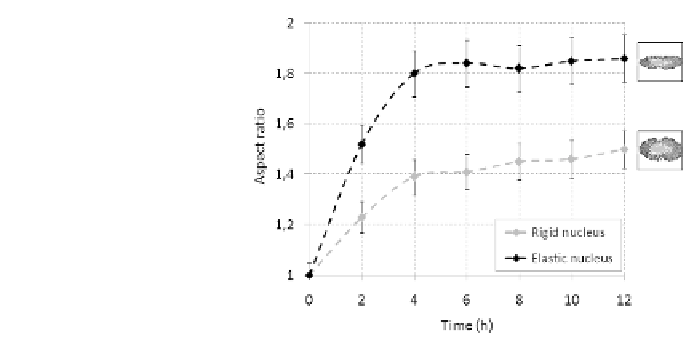Biomedical Engineering Reference
In-Depth Information
FIGURE 9.9: Dependence of migration-associated cell morphology over
time on nuclear deformability. Evolution of cells aspect ratio during mi-
gration through small pore sizes (i.e., 5 m) and high ber stiness (i.e.,
perimeter
F
= 11). The light line represents cells with a standard rigid nucleus
(
surface
;N
= 8:5) and the dark line represents cells with an elastic nucleus
(
surface
;N
= 0:5). All the other model parameters are the same as the stan-
dard simulation of Figure 9.1. Note that a high deformability of the nucleus
allows cells to undergo dramatic morphological transitions fundamental for
their migration in highly constrained environments. The values are given as
means s.d. over 50 randomly selected cells.
ity, as moving cells do not experience steric hindrance. However, once mesh
dimensions and scaffold rigidity move to intermediate ranges, nuclear elastic-
ity somewhat facilitates cell movement, measured as MSD. The persistence
time does not contribute to such an increase; i.e., cells with rigid nuclei were
already able to migrate through the matrix networks characterized by inter-
mediate dimensions without changing direction. On the contrary, the velocity
does; i.e., they can quickly and eciently remodel.
Finally, as pore size and matrix elasticity further decrease toward a highly
constrained environment (lower{right corner), the simulations demonstrate
that enhanced nuclear deformability is associated with enhanced cell migra-
tion. Such a facilitated locomotion is mediated by an elongated and deformable
nuclear configuration allowing the entire cell to squeeze and stretch more eas-
ily and thereby pass through the steric obstacles of a dense and rigid matrix
(Figure 9.9).
Our simulations relate to a number of experimental works, such as [408],
where cell migration eciency decreases with matrix density and is associated
with nuclear deformation, or [27], where glioma cell lines significantly deform
their nucleus upon recruitment of nonmuscle myosin II (NMMII) for squeezing







Search WWH ::

Custom Search